

Damion Smy
Boxy new KGM Musso unveiled to take on HiLux and Ranger ahead of Australian launch
9 Hours Ago
Audi's SQ7 and SQ8 performance SUV twins are powerhouses that demonstrate all of the Ingolstadt brand's latest developments.
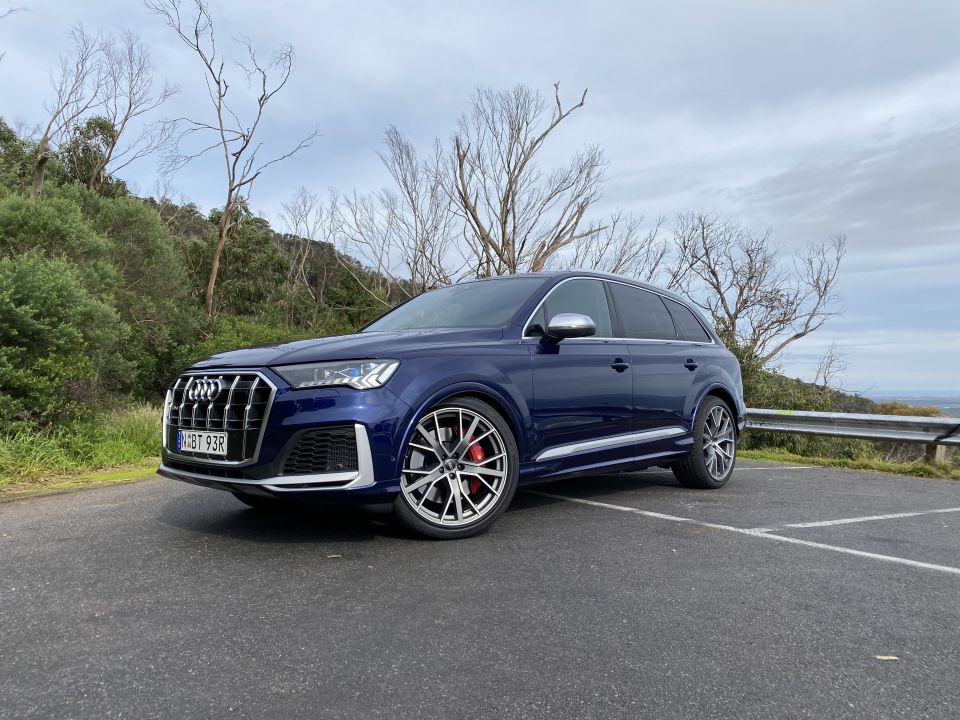
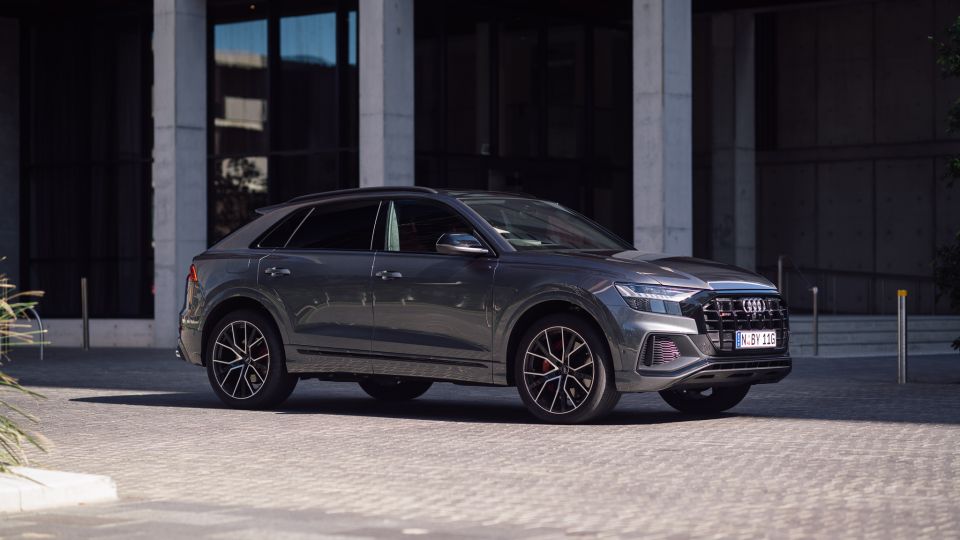

Senior Contributor
New from
$161,500
excl. on-roads

Senior Contributor
New from
$161,500
excl. on-roads


Senior Contributor
New from
$161,500
excl. on-roads

Senior Contributor
New from
$161,500
excl. on-roads
Quickly see how this car stacks up against its competition. Select any benchmark to see more details.
Where expert car reviews meet expert car buying – CarExpert gives you trusted advice, personalised service and real savings on your next new car.
Do you hear that? It’s the sound of Audi capitalising on Australia’s ravenous demand for SUVs with two high-riding flagships: the updated Audi SQ7 and brand-new Audi SQ8.
This pair are twins under the skin: the SQ7 taking the edge in practicality thanks to a third seating row, and the frameless-window-toting SQ8 playing the role of style leader as Ingolstadt’s answer to sporty crossovers such as the BMW X6 and Mercedes-Benz GLE Coupe.
Both offer V8 diesel engines, a point of difference in a world where big SUVs using petrol or hybrid drivetrains are becoming more common. Each is also loaded with the very latest cabin tech, safety features, and dynamic driving aids that the four-ringed brand can muster.
This story is based off a single-day launch experience, so we’ve combined them into one. More detailed garage reviews will follow in due course.

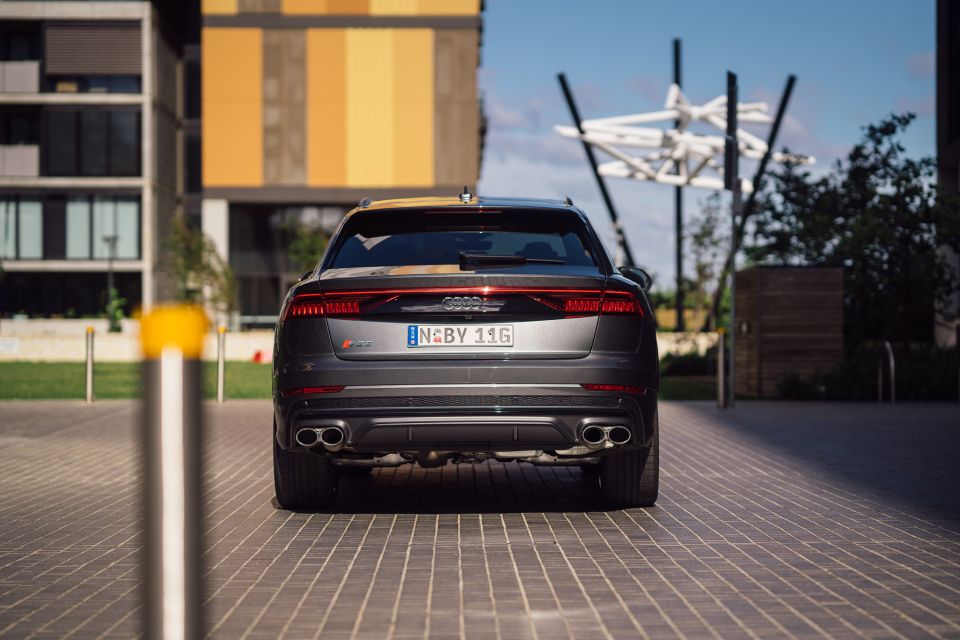
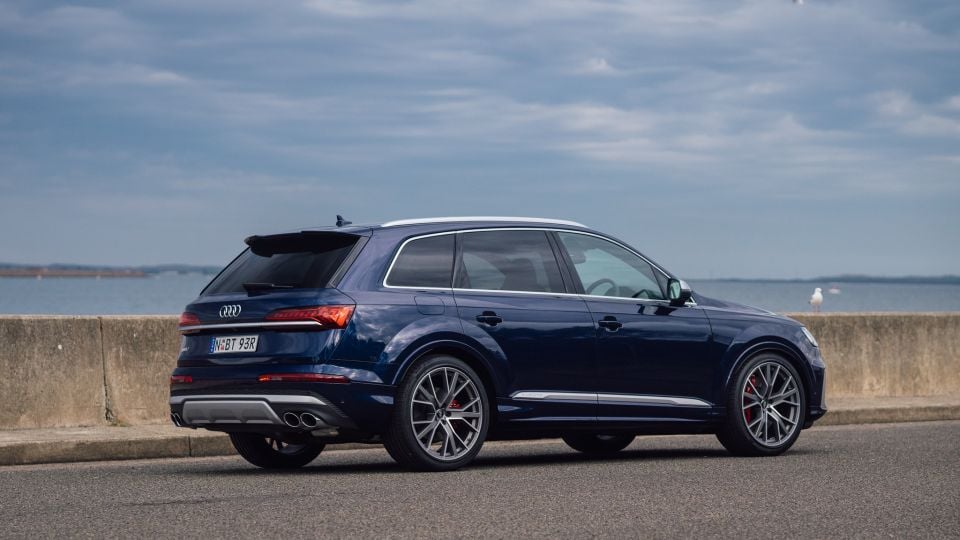

The Audi SQ7 is an unchanged $161,500 before on-road costs but gets an additional $15,000 worth of features as part of its 2020 update, according to Audi.
Despite having two fewer seats, the Audi SQ8 is pricier at $165,500 before on-road costs. That’s the price of style…
The SQ7’s most obvious rivals are fellow go-fast seven-seaters, the BMW X7 M50i petrol ($171,900) and less powerful Mercedes-Benz GLS400d ($153,300).
The SQ8’s nemeses include the BMW X6 M50i ($155,900) and Porsche Cayenne S ($166,200).
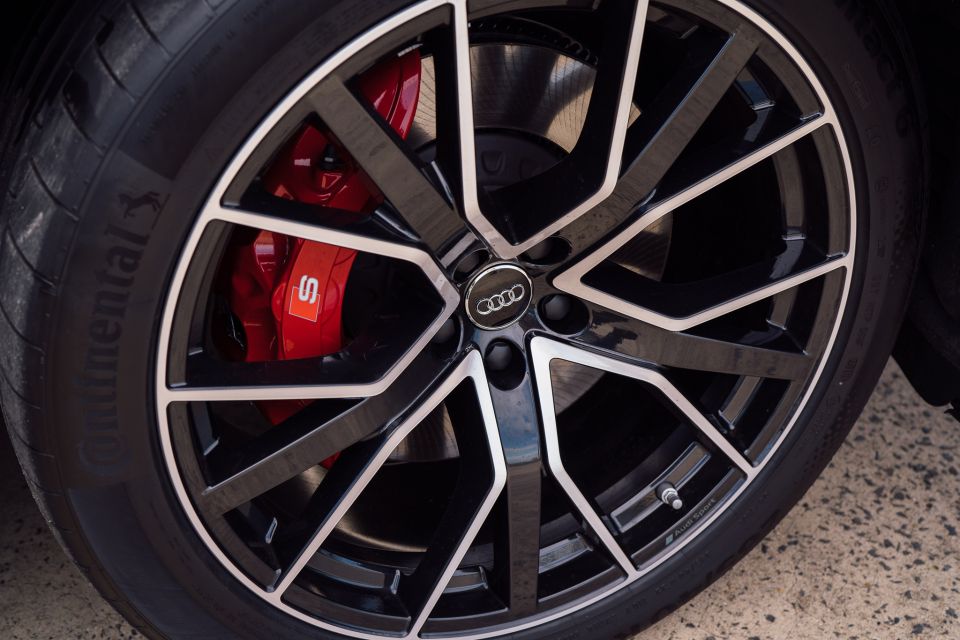
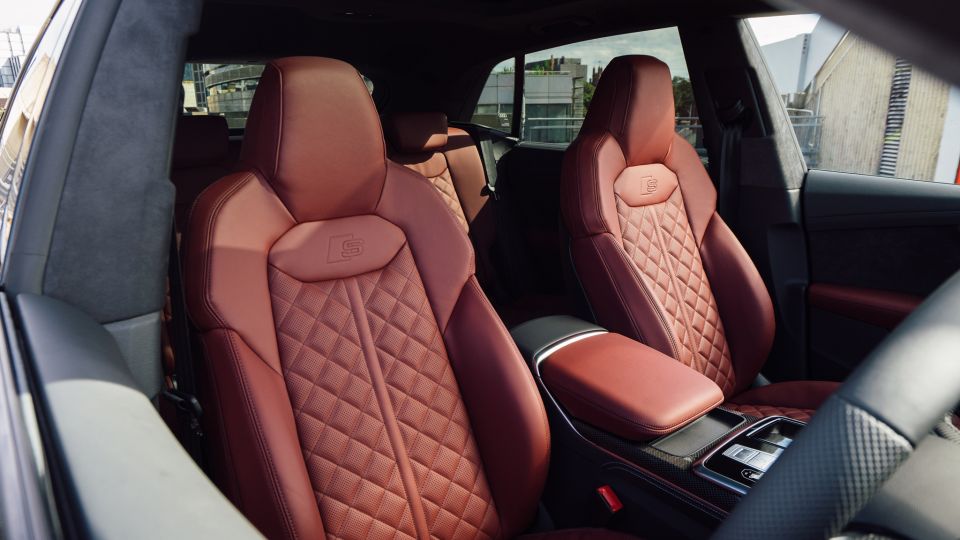
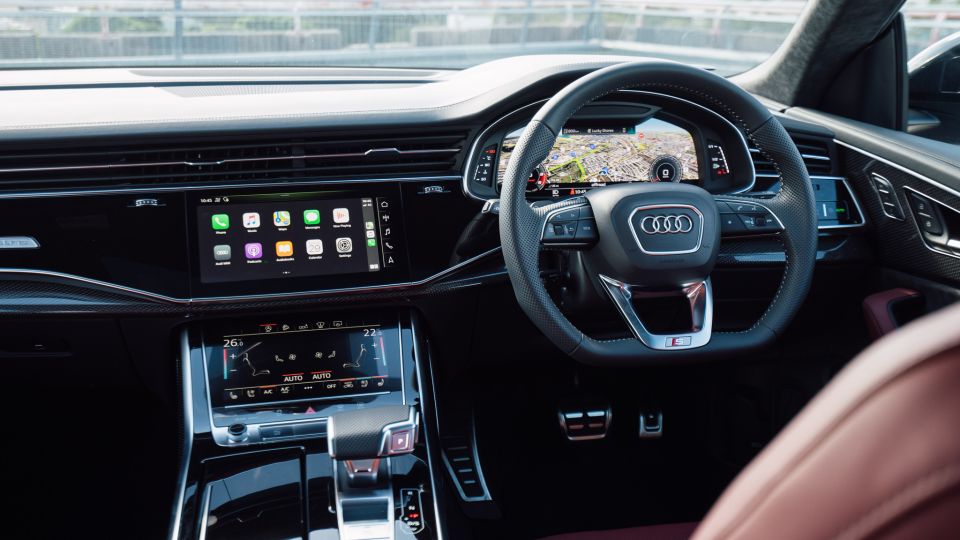
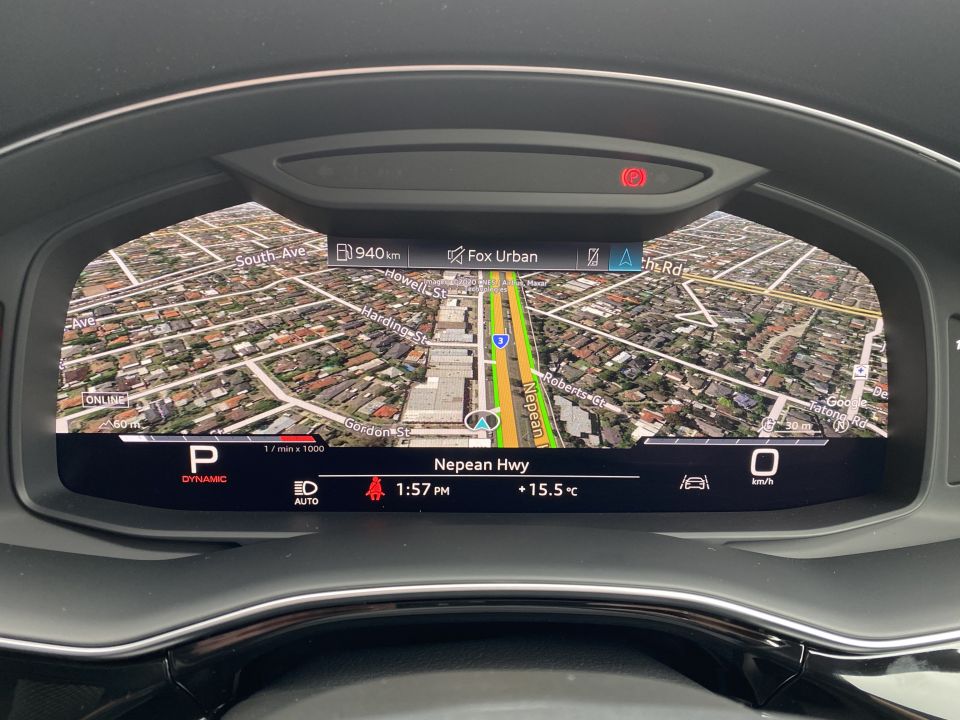
A better is question is what don’t you get.
Both have 22-inch wheels, rear-wheel steering (opposite direction at carpark speeds, same direction at higher speeds), selectable driving modes, and adjustable air suspension.
Add to that a panoramic glass sunroof, power-operated soft-closing doors, and HD Matrix LED headlights with sensor-based high beam.
Each comes with seats trimmed in Valcona leather pinched from the A8, an electric steering column, four-zone climate control, seat heating up front (seat ventilation is standard on the SQ8, optional on the SQ7), and changeable ambient LED interior lighting.
There’s also the 12.3-inch Virtual Cockpit digital instrument cluster augmented by a projecting head-up display (HUD), a 10.1-inch centre display with acoustic and haptic feedback, satellite navigation and Google Earth overlays, a 360-degree camera, a wireless phone charger, wireless Apple CarPlay, speech recognition, four USB ports, and digital radio.
Each also has a supplementary 8.6-inch haptic touchpad display underneath that houses all ventilation controls, and a few other shortcuts, such as HUD adjustments.
The Audi SQ7’s 3D sound system comes from Bose and has 19 speakers, a subwoofer, a 15-channel amplifier, and 558W of power. The Audi SQ8’s is sourced from Bang & Olufsen and has 17 speakers, a subwoofer, a 16-channel amp, and power of 730W.
There aren’t all that many options, and even the metallic paint is free.
There’s a Sensory package that adds a 23-speaker, 1920W B&O sound system, Alcantara headlining, front seat massagers (and ventilation on the SQ7), rear seat heating, leather dashboard, an air ioniser, and fragrance dispenser. It costs $13,300 in the SQ7 and $13,900 in the SQ8.
There’s also the $10,900 Dynamic package that adds electro-mechanically actuated active-roll stabilisers at each corner, and a quattro sport differential that controls the torque distribution across the rear axle (up to 85 per cent of engine torque can be sent rearward), and which augments the existing brake-torque-vectoring system.
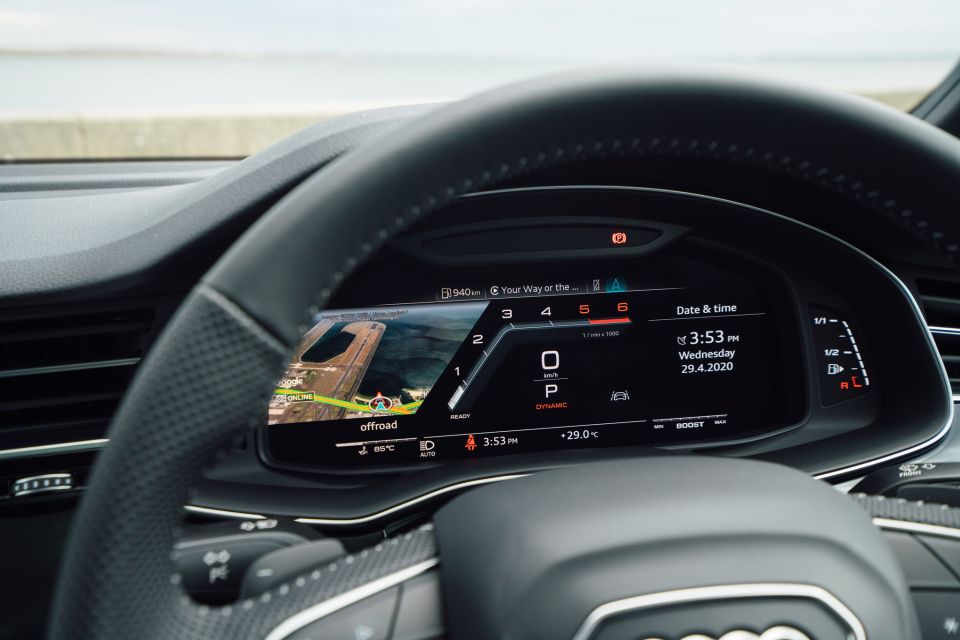
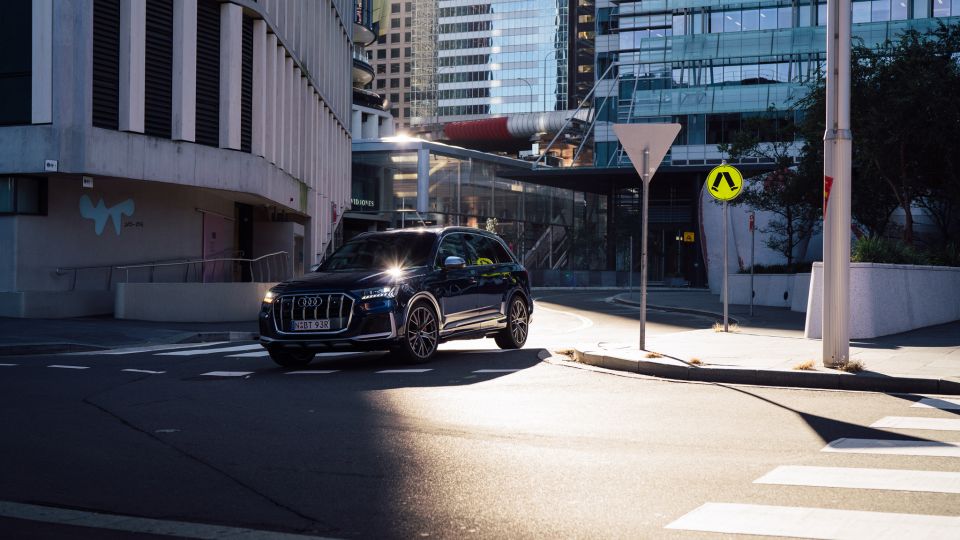

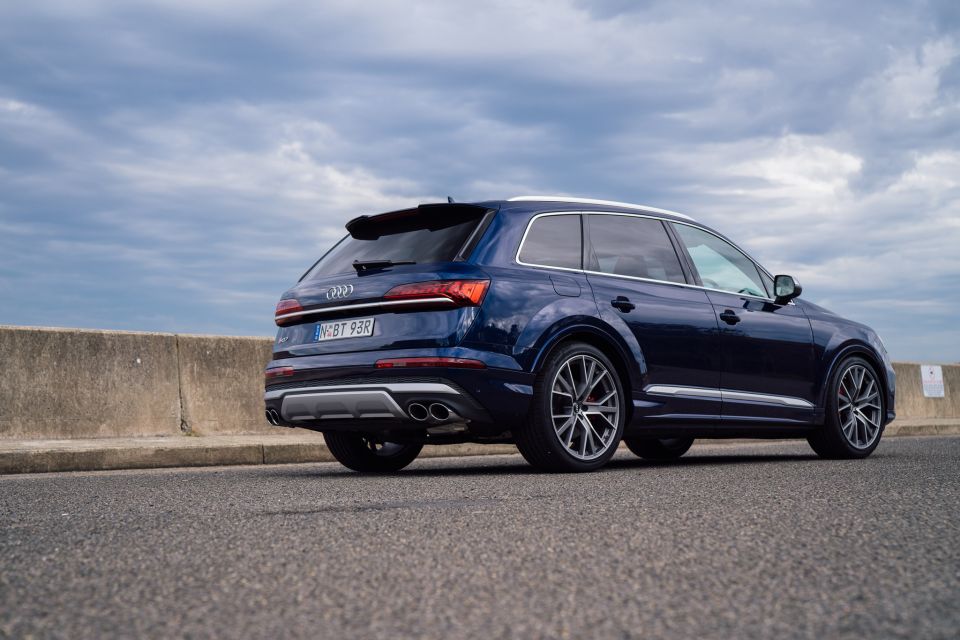
The SQ8 received the maximum five stars from ANCAP in 2019, and the Q7 in 2015 when the pre-updated model launched. Euro NCAP updated its Q7 five-star rating by re-testing it in 2019, and the scores apply to Australia.
Both get autonomous emergency braking (AEB) designed to mitigate collisions with other cars up to 250km/h and with pedestrians below 85km/h, collision avoidance assist, lane-keeping assist with steering intervention, blind-spot monitoring, automated parking software, rear cross-traffic assist, adaptive active cruise control, and a system called ‘exit warning’ that alerts you if you’re at risk of opening your door into the path of a cyclist.

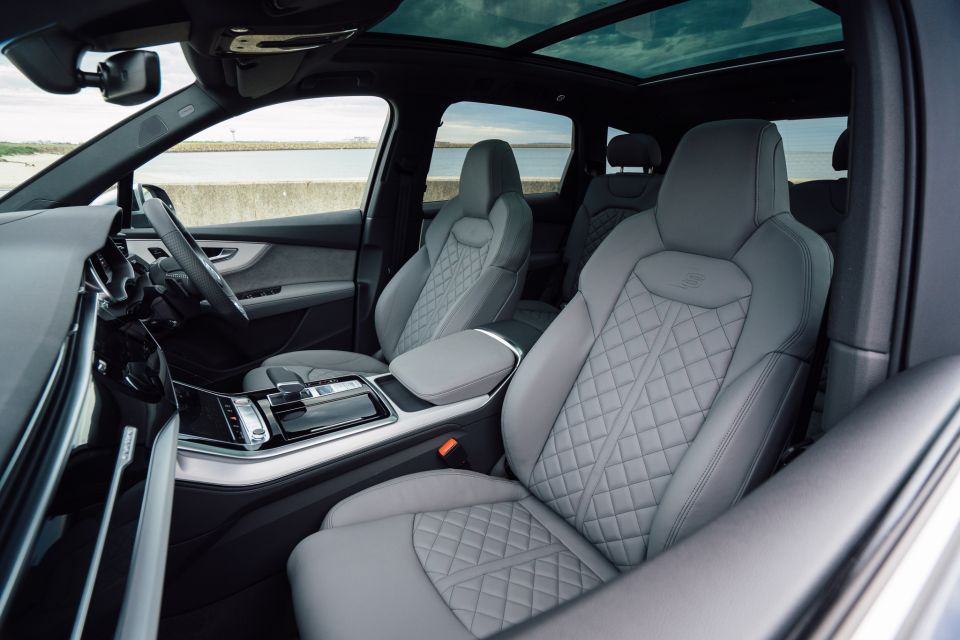
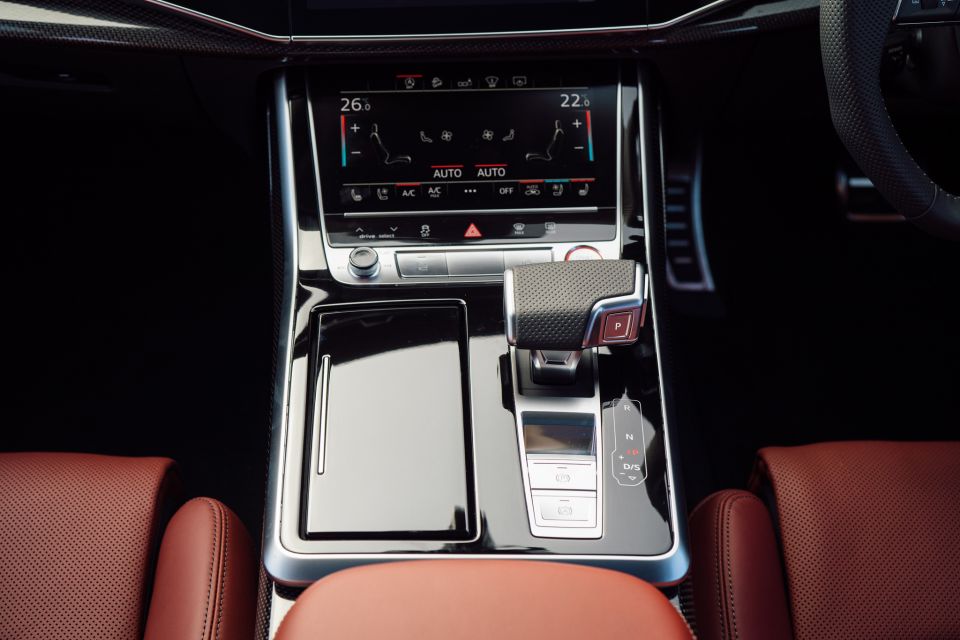

There is an attention to detail evident that Volkswagens don’t display, and even by Audi’s lofty standards these interiors feel a bit special. Each button, switch and dial feels expensive.
The leather on the seats and contact points is soft and the stitching immaculate, the metal and suede trims scattered about are quality, and the steering wheel with electric reach and rake adjustment is beautiful. It feels like every aspect has been carefully considered.
It’s also a technology showcase. The digitised instrument display is adjusted by steering wheel buttons, brims with information like zoomable maps, and both loaded and operated without lag. The lap-timer seems extraneous though!
The centre screen no longer sits atop the dash reliant on a rotary controller and trackpad, but is rather a touch surface integrated in the horizontally laid-out fascia. Each touch point also gives haptic feedback, so you feel some reassuring resistance to your finger.
It swipes and loads like a phone, and the operating system is simple. The voice control won’t respond to requests until you press a button, unlike BMW and Mercedes systems summoned by key words, but it’s a helpful shortcut for audio, navigation, and telephone calls.
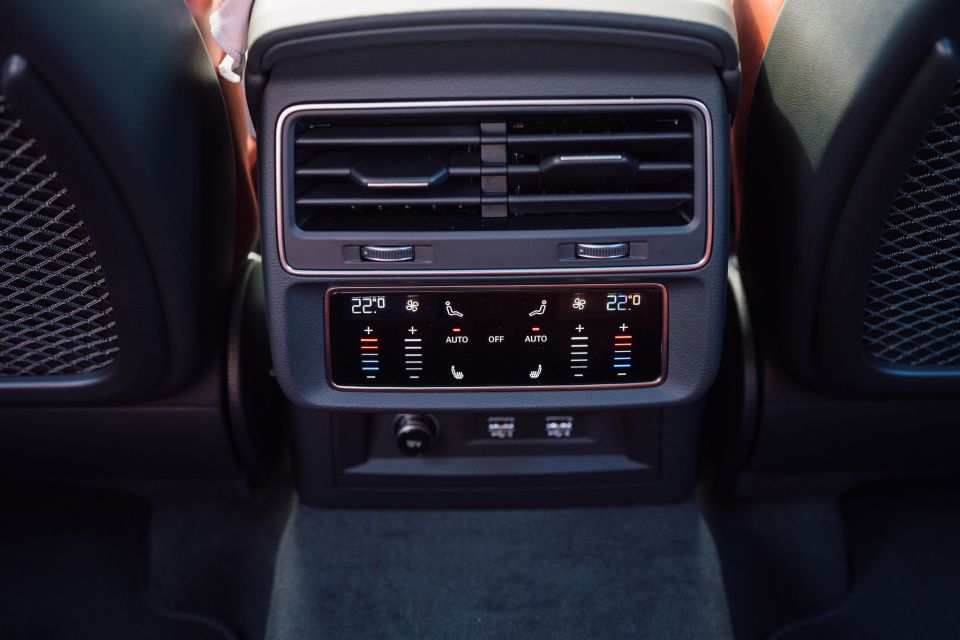
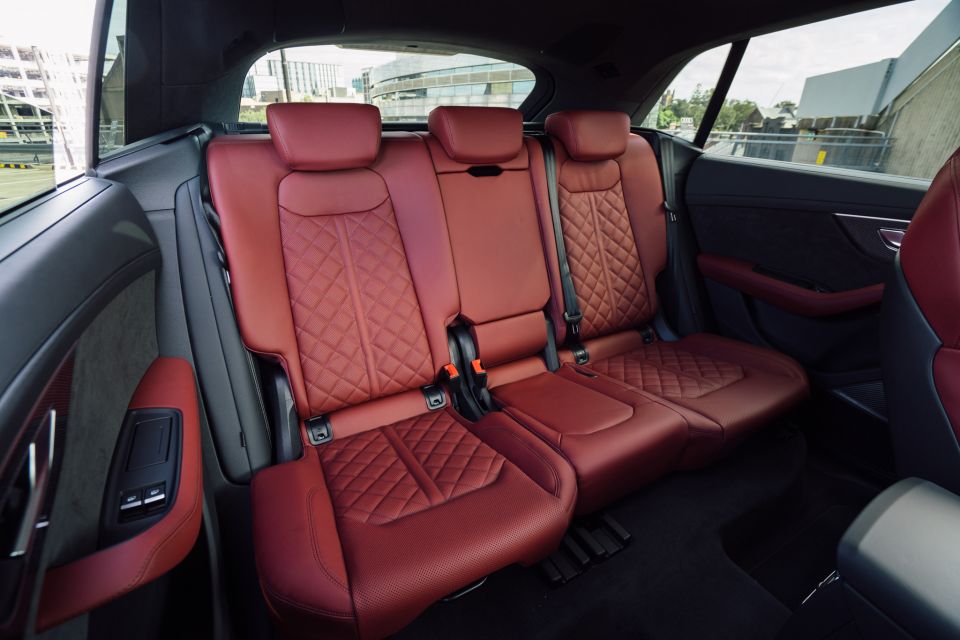
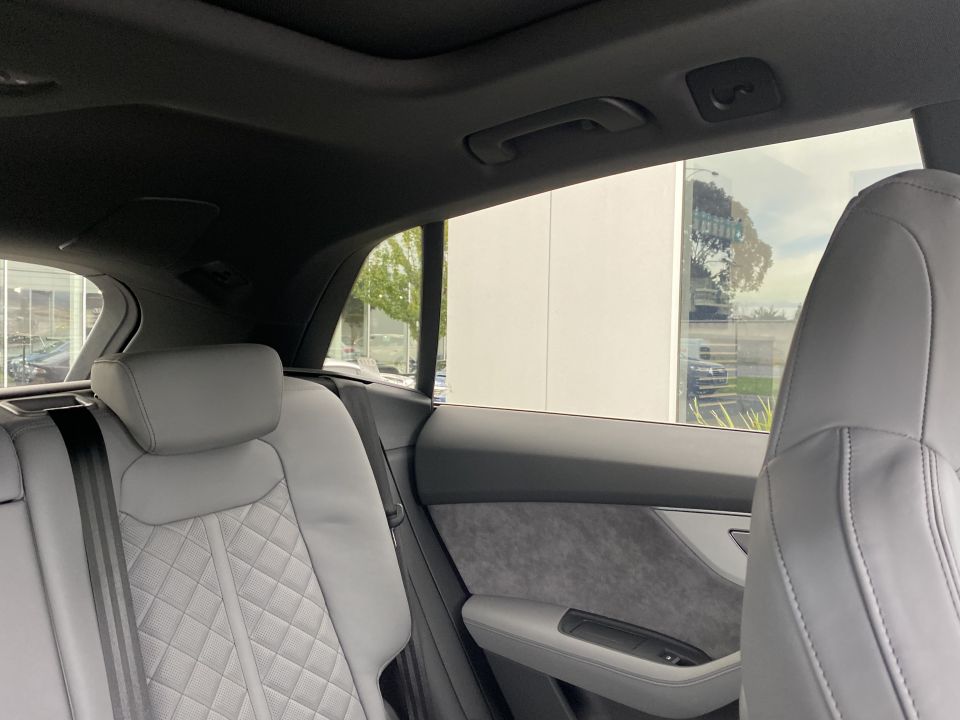
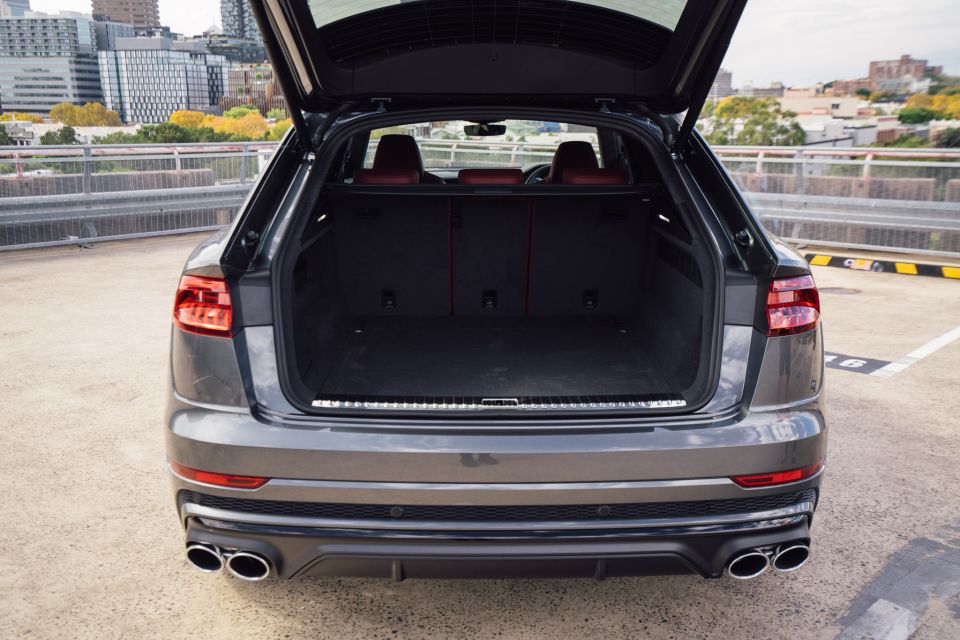
If you prefer phone mirroring you get wireless Apple CarPlay or wired Android Auto, and a charging pad in the disappointingly shallow centre console. The felt-lined glovebox and plastic door bins are more capacious.
You control ventilation or heating through a second touchscreen with haptic feedback situated below the infotainment display. I also like the fact this lower touchscreen has shortcut menus to control the HUD settings and ambient lighting setup.
If there’s a gripe, the proliferation of glossy black surfacing and double screens attract fingerprints, dust and sun reflection to the point of becoming an irritant. The fact our press car came with an Audi offical cleaning cloth says a bit, doesn’t it?
Space is the second row for both is generous, and the material quality doesn’t take a step backwards relative to the the front. I’m 194cm and sat behind my own ideal seating position, with plenty of headroom despite the full-length glass roof. The Q8’s headroom is tighter.
The large side windows create an airy feel, and amenities include dual-zone rear climate control operated by a touchpad fitted on the back of the centre console. There are vents above the touchpad and also on the B-pillars, plus LED reading lights, and two USB points.
For the kid-friendly SQ7, the back of each front seat is shelled with a harder-wearing trim, and the 40/20/40 three-part bench houses three sets of ISOFIX child-seat anchors and top tether points. All three base portions in the SQ7 slide on rails.
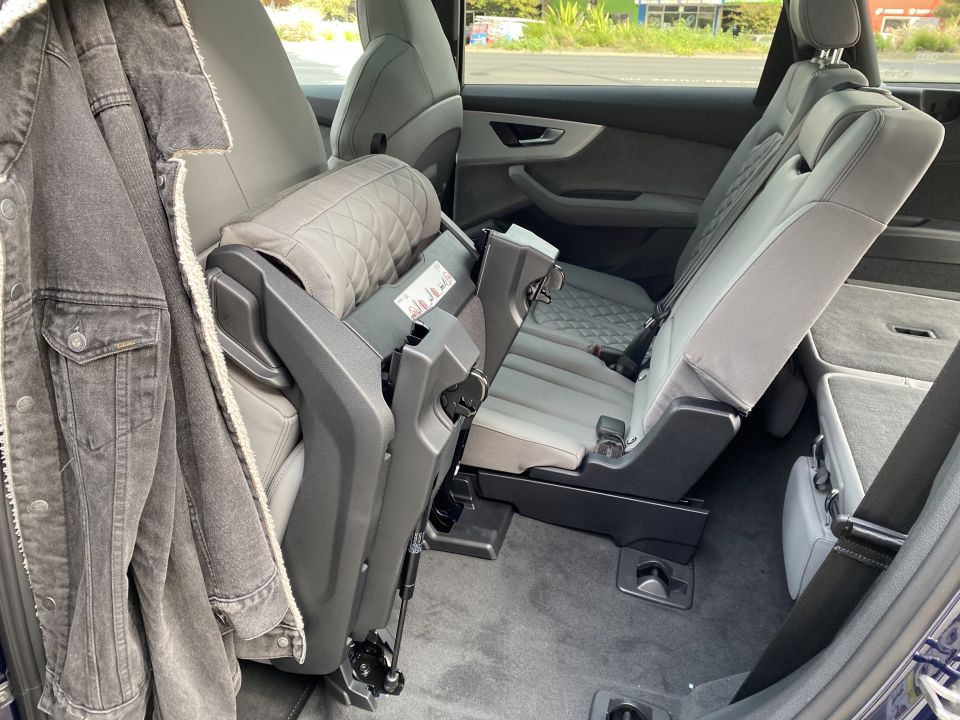
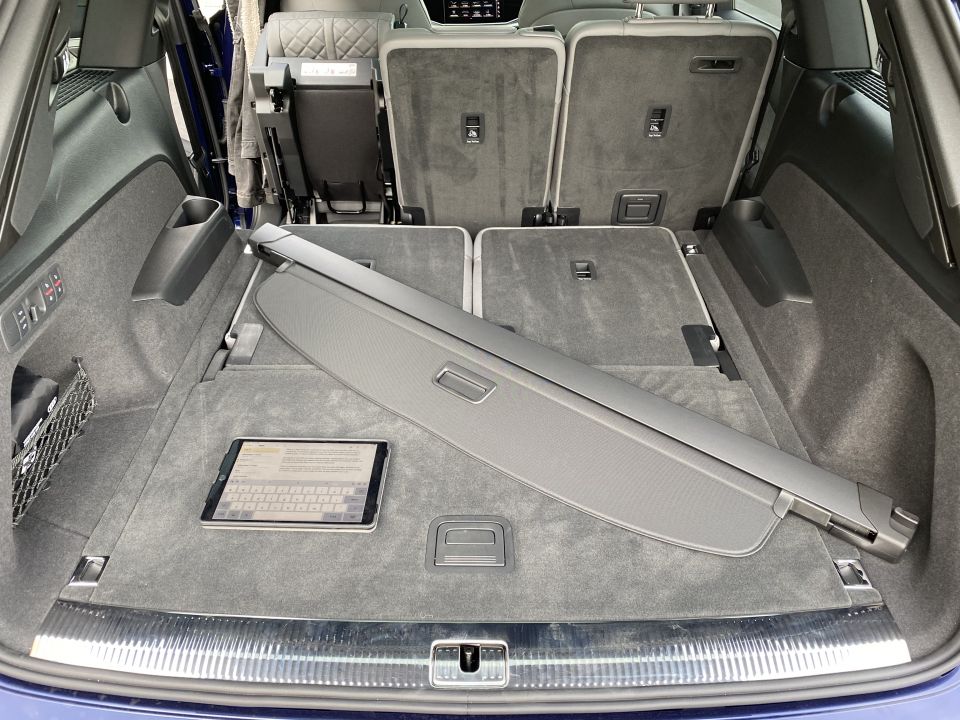
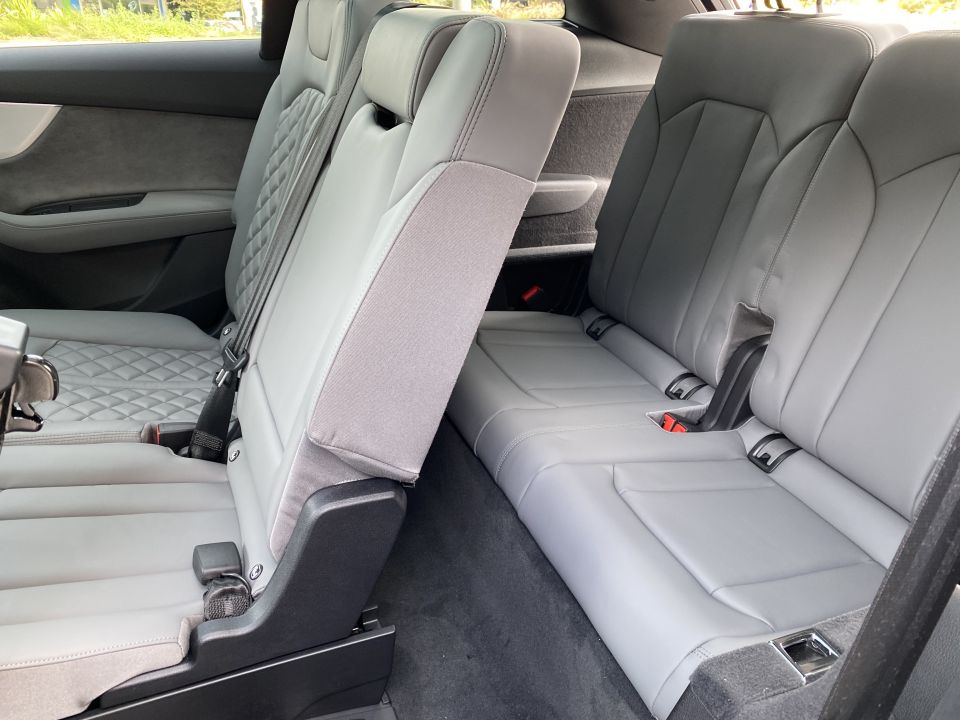
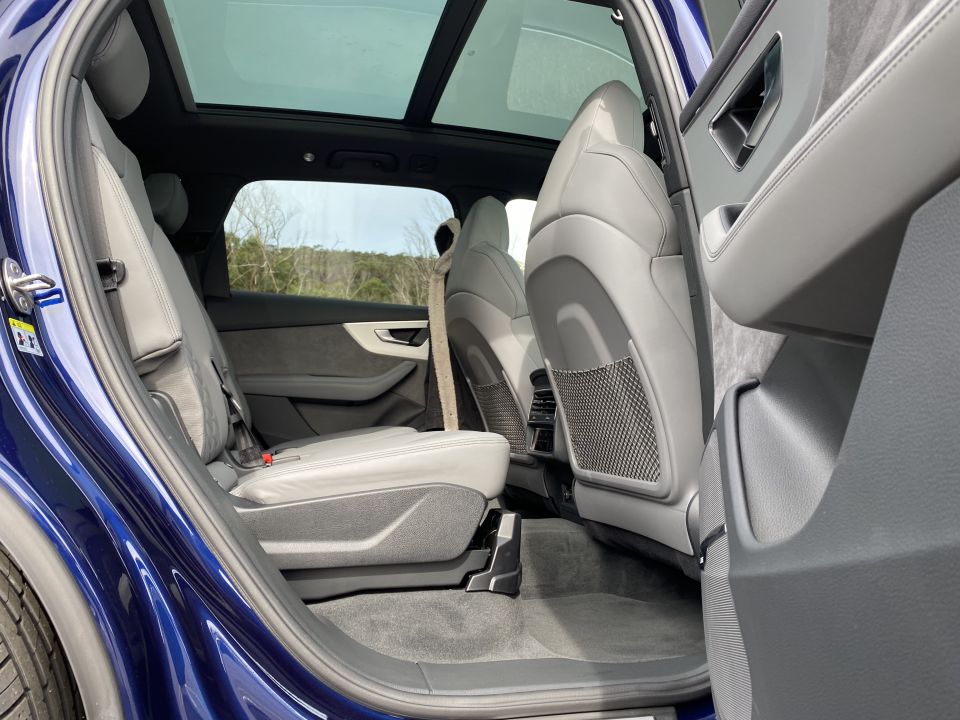
Access to the SQ7’s third row is achieved by pulling a lever on the kerb-side middle-seat base that folds its back down, and then pulling on a different handle to flip the seat’s base up on its pneumatic damper.
There is a bank of electric switches to take the third row from flat in the floor to operational. To maximise legroom in the third row, which is best saved for kids or smaller adults, it’s best to slide the middle row seats to a more forward position.
Occupants in the third row enjoy a decent window, reading lights and cup holders, and there are airbags that deploy from the D-pillar behind the occupants’ heads. But there are no dedicated third-row air vents or USB points.
There is a second switch bank to fold those third row seats flat again situated in the cargo area. The pull-out cargo cover is versatile but there’s no dedicated place under the floor to store it when not in use. The storage capacity in the SQ7 is 705 litres behind the second row, whereas in the SQ8 it’s 605L.
Like many cars with air suspension you can also press a button in the cargo area to lower the car, making loading easier.
Those planning on using the SQ7 for road trips should be aware that there’s no spare wheel of any type fitted, just a repair kit, whereas the SQ8 has a space-saver temporary spare that’s more reassuring. The lack of third-row seats frees up under-floor space, clearly.
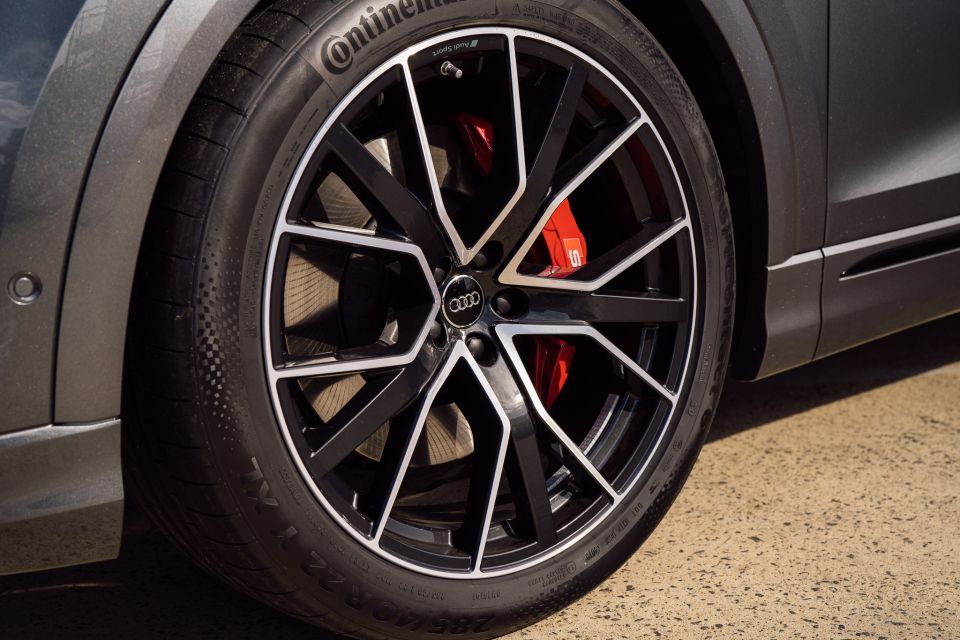
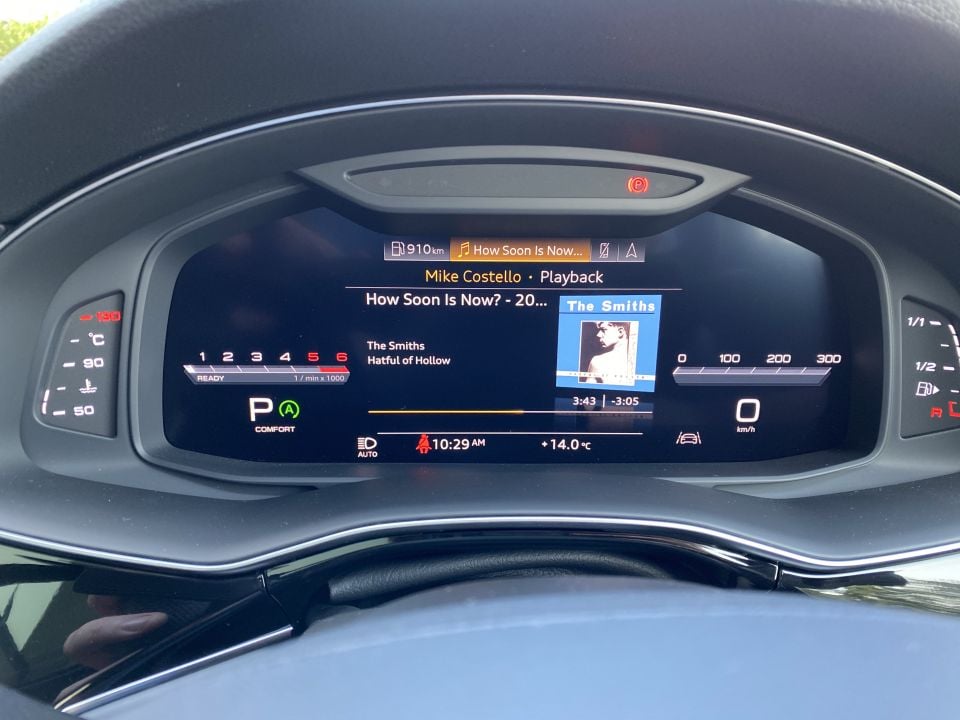
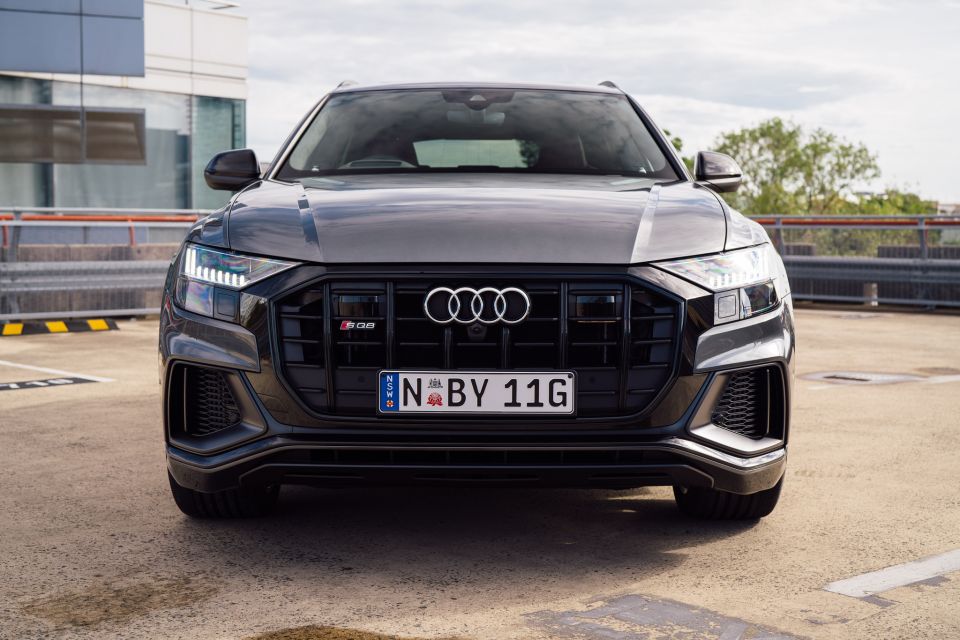
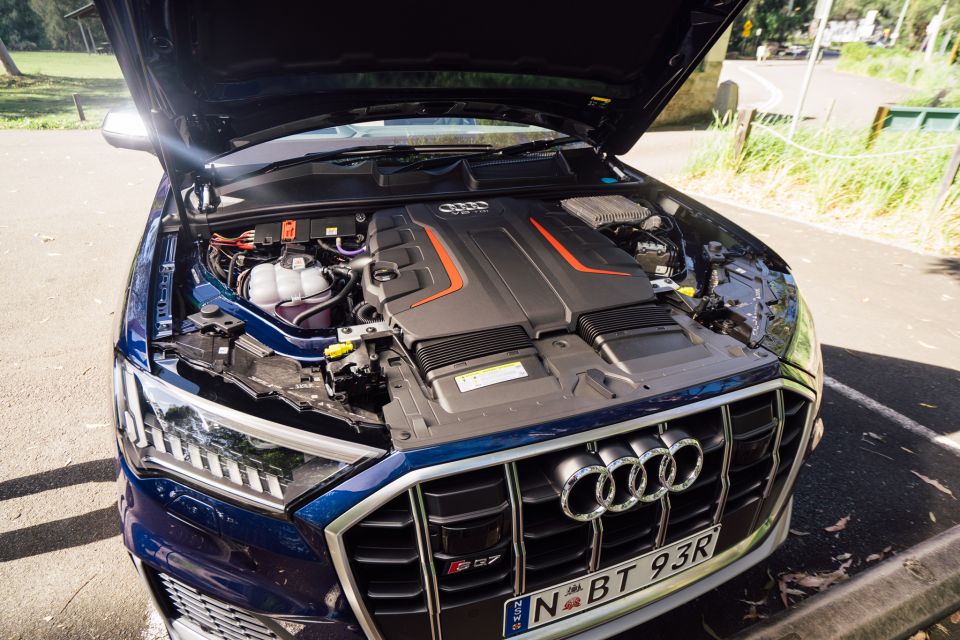
Performance diesels, you say? Let us not forget that this pair each weighs in excess of 2.4 tonnes…
It’s a V8 with a 4.0-litre capacity, producing 320kW of peak power between 3750 and 4750rpm, and a spectacular 900Nm of peak torque between 1250 and 3250rpm. That’s twice the torque of a Toyota HiLux.
It’s matched to a permanent all-wheel drive system and an eight-speed automatic gearbox with paddles, and can catapult either car to 100km/h in 4.8 seconds on the way to a governed 250km/h top speed.
The engine’s two turbochargers work sequentially and have up to 2.4 bar of boost pressure. The secondary turbo in the sequence activates above 2200rpm via Audi’s valvelift system.
A 48V onboard electrical system powers the compressor that supplements turbos’ EGR, minimising lag. Its 7kW electric motor accelerates the compressor wheel up to 70,000rpm in 250 milliseconds.
The 48V system also powers a belt alternator-starter connected to the crankshaft. Energy can be recuperated and sent into the 0.5kWh battery during braking.
The claimed fuel consumption on a combined cycle is as low as 7.6L/100km. Thankfully, both the SQ7 and AQ8 are also rated to tow 3.5 tonnes.
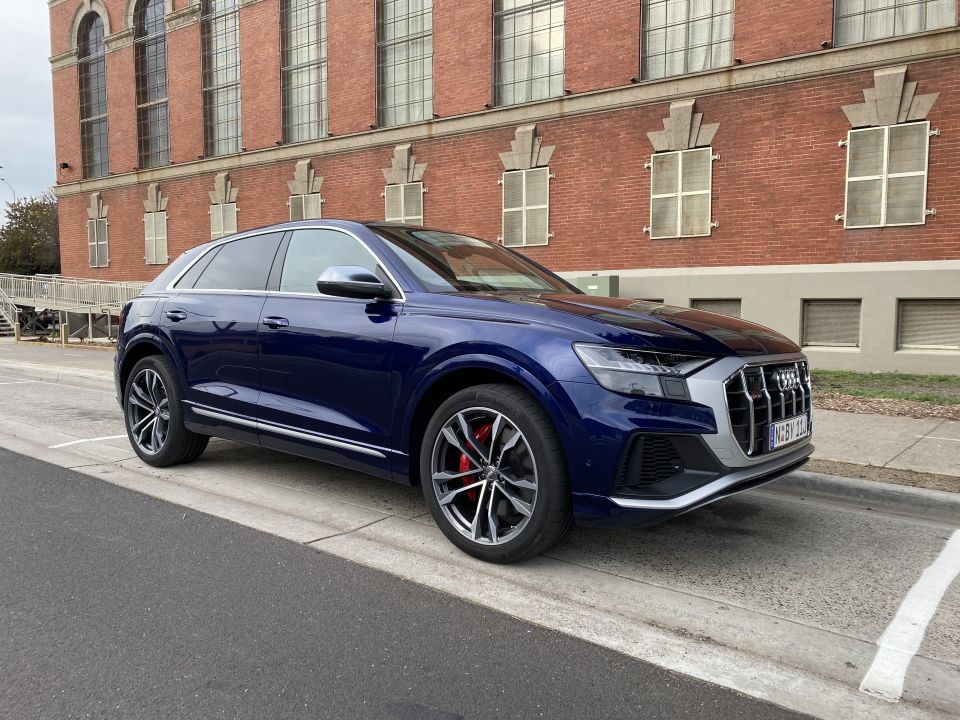

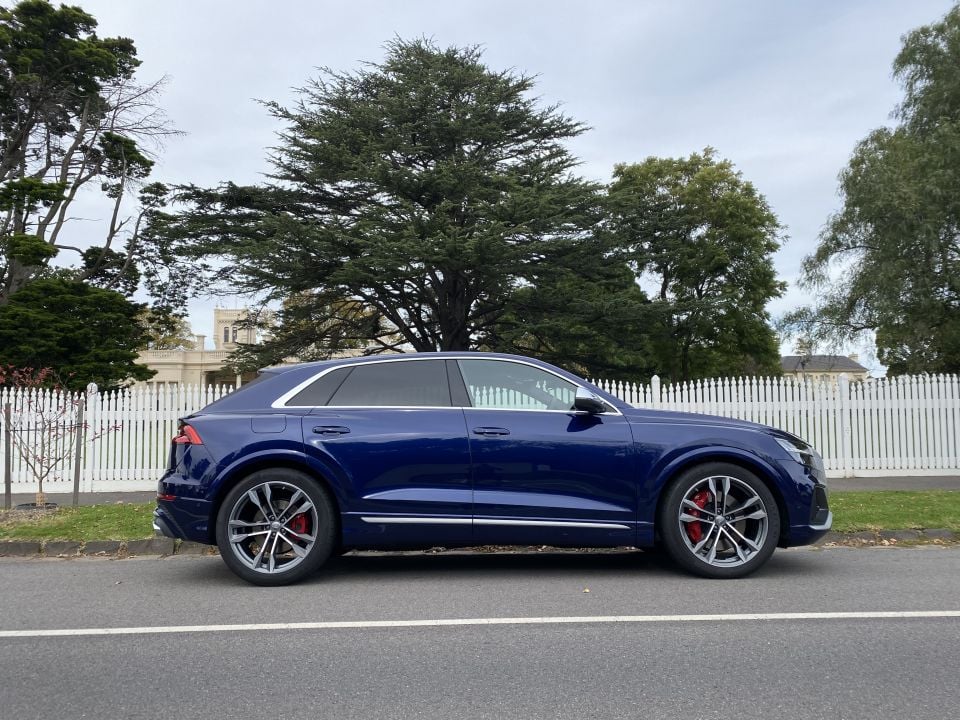
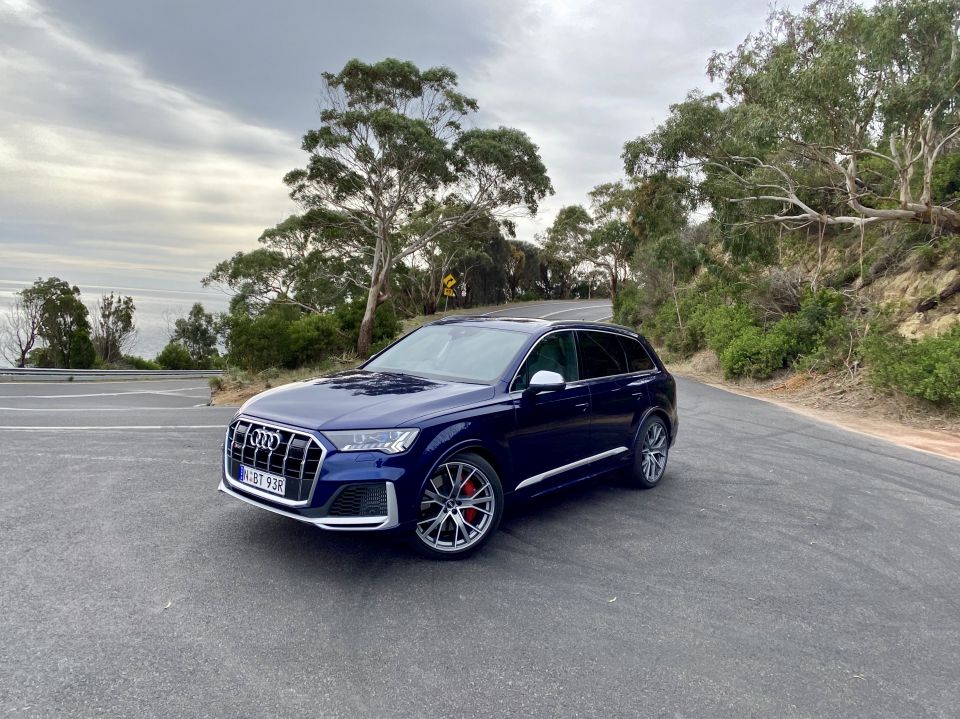
In typical operation the V8 is disarmingly smooth and quiet, so much so that from the outside it could easily be a slightly rough petrol.
A quiet 80km dawdle down the Mornington Peninsula from Melbourne was an ideal first test. At 100km/h the engine sat at just 1300rpm while sipping about 7.5L/100km.
Flick the car over to its sports mode and the the engine note inside the cabin becomes gruffer and meaner. Even after a few jaunts up Arthur’s Seat hill I was averaging a respectable 9.3L/100km.
This sort of engine is well suited to something this big, with endless reservoirs of torque to lean on. It always feels effortless, though never as urgent, sonorous or outright aggressive as a turbocharged petrol V8 might.
In stop/start urban traffic, the 48V electrical architecture supports a coasting function sans engine down hills, and an idle-stop system that is particularly smooth and free of jerkiness, though I wasn’t able to get it to activate while the car was still rolling.
The presence of a conventional automatic with torque converter rather than a double-clutch S tronic transmission helps in this department further.
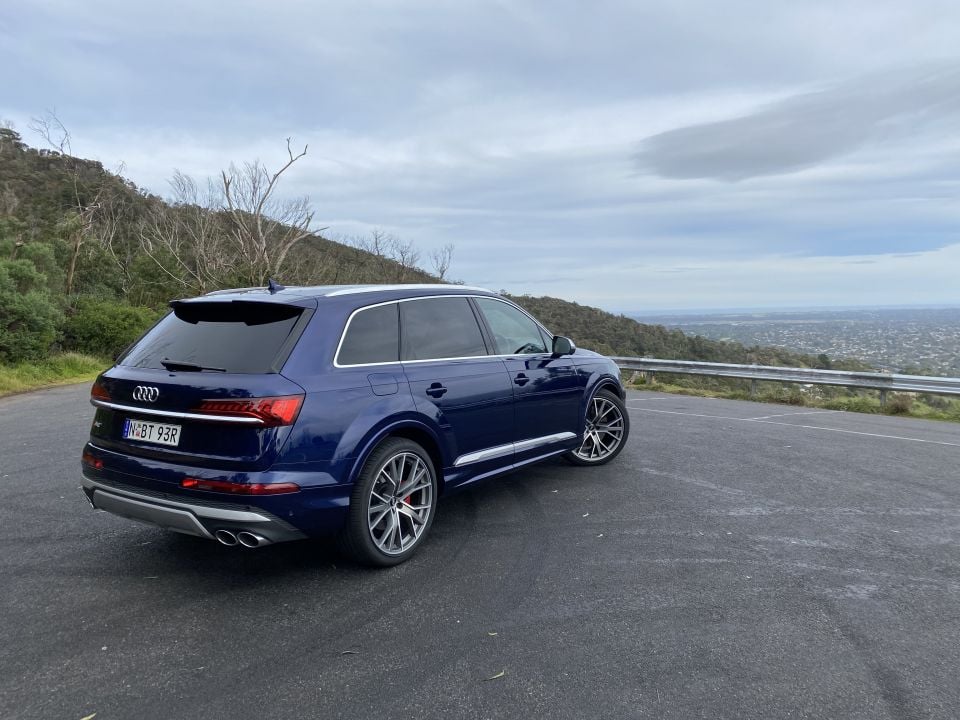
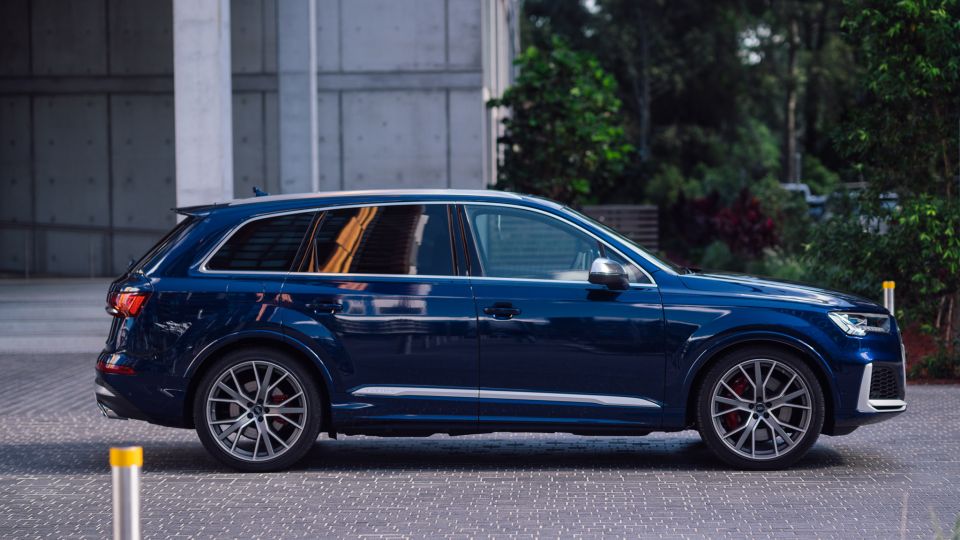
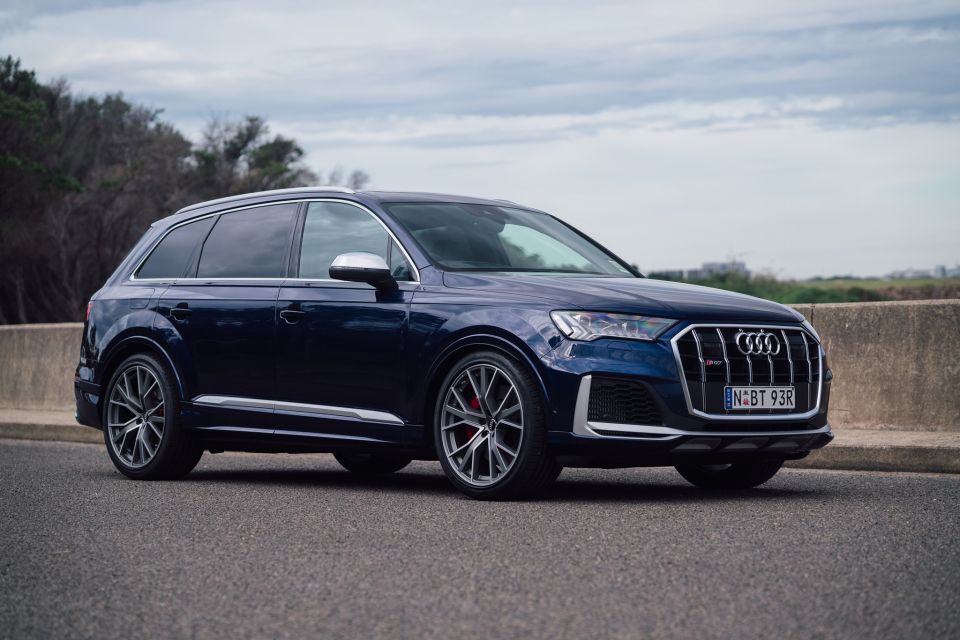
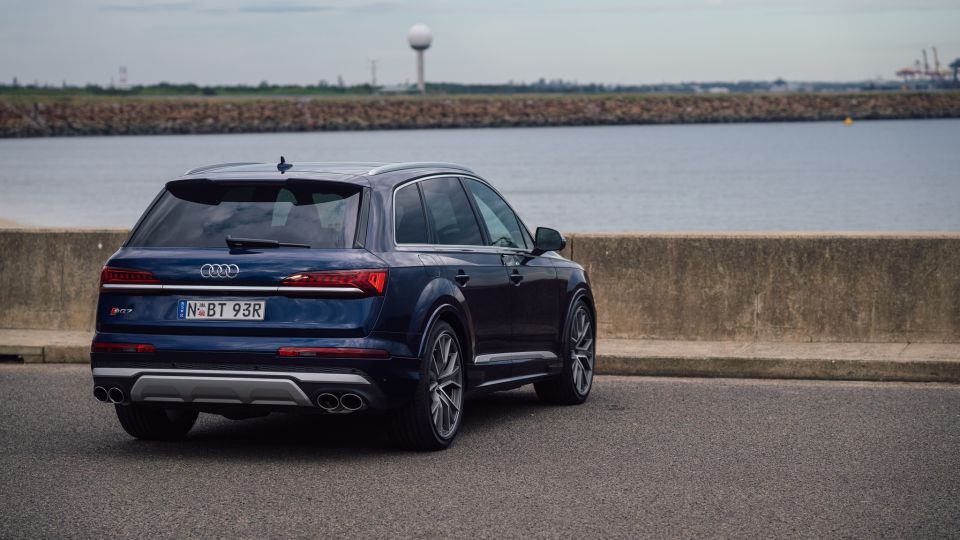
The ride quality is pretty good for a car riding on slim sidewall 285/35 tyres at both ends (sourced from Hankook on our SQ7, and by Continental on the SQ8). The adjustable air suspension filters out all but the sharpest hits in the comfort setting.
In the sport setting the body feel definitely comes tauter, with more road vibrations and oscillations entering the cabin, accompanied by extra steering resistance.
It’s also quiet, over all but the coarsest bitumen. At one stage I recorded myself whispering at 100km/h with the recording device sat on the console and it came out clear.
You can pay the $10,900 mentioned earlier and option up the electric anti-roll stabilisers which purport to keep the body flatter through corners, but even without them the SQ7 negotiated tight twisty roads with unusual alacrity for such a big wagon.
Standard rear-wheel steering gives you a tighter urban turning circle, because those rear wheels at low speeds face by a few degrees the opposite direction to the fronts. Audi claims this more-than-5m-long pair have the same turning radius as the far smaller Q3 as a result.
For those looking at doing a snow trip or some muddy trails, the off-roading modes tell the air suspension to go to its maximum height and change the way the stability control responds to slipping. It can raise up 35mm, giving you 254mm of clearance, below 30km/h.

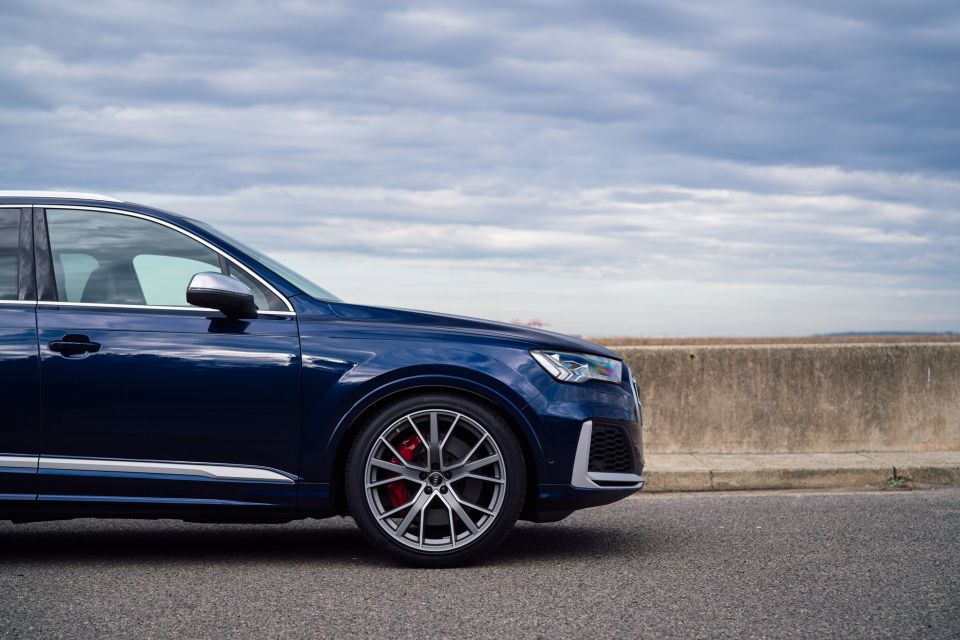

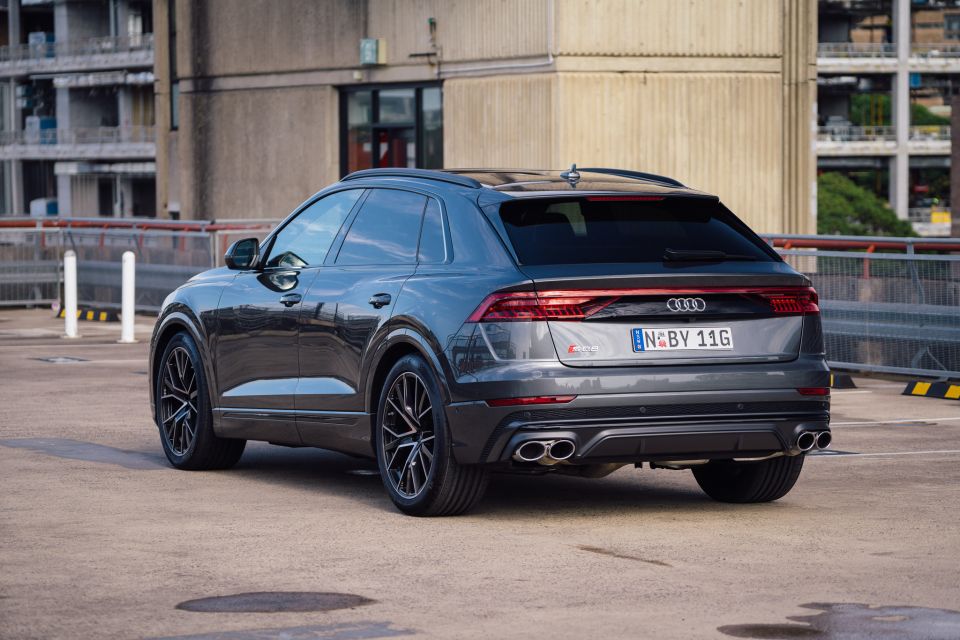
The quattro all-wheel drive system has a self-locking centre diff and can apportion up to 70 per cent of engine torque to the front and 85 per cent to the rear.
The SQ8 we drove was fitted with the quattro sport differential and it did feel a little more agile and nimble, slightly tail-happy even, than its larger sibling that went without. I’d love to do a back-to-back track slalom in Q8s with and without…
You can option carbon-ceramic brakes but honestly, don’t. The normal stoppers with six-pistons and 400mm diameter at the front, and 350mm diameter at the rear, are fine. By all means option the sexy red calipers.
The final piece of the puzzle is the car’s driver assistance features. The lane assist has its own display in the HUD and driver’s instruments alike, and the steering kept the car reliably centred in the lane where road lines were clearly painted. In this case on the Peninsula Link.
The SQ7 and SQ8 are offered with the Audi service plan package, priced at $2870 for three years or $3910 for five years at annual/15,000km intervals.
While the company is currently offering s five-year warranty as a campaign special, Audi’s website still lists a three-year warranty as standard.
There are very few brands left that do not warranty their cars for at least five years now, so feel free to push for the same coverage irrespective of when you buy.
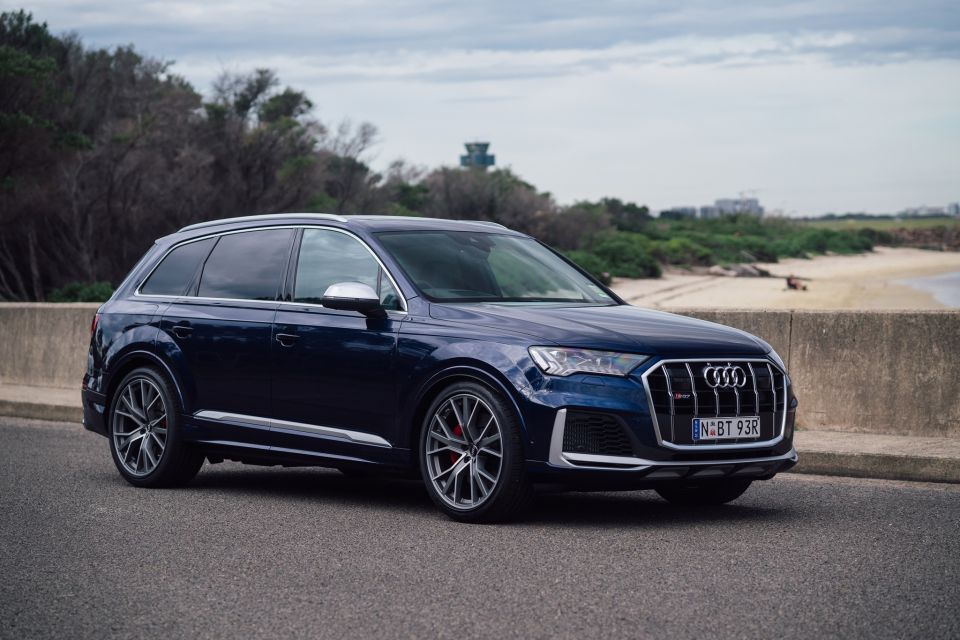

When Audi is on, it’s on. And there’s a sense that in the SQ7 and SQ8, the brand had a clear vision.
The SQ8 looks fantastic in the metal, and its toweringly torque-laden engine makes it a consummate hauler. I cannot fathom how one might think a GLE Coupe, X6, Cayenne, or even something left-field like the Maserati Ghibli look more desirable.
On a side note, a petrol-fired V8 RSQ8 derivative is on the way if you want even more ferocity.
The SQ7 is even more of a standout, because it is a genuinely practical family SUV that lacks little in the way of comfort, safety and tech, looks menacing in an understated way, and stacks up on price and spec well against its small competitor set. It’s a fairly unique package.
While neither are likely to move you like something from the madcap AMG engineers in Affalterbach, both of Audi’s S-badged SUV flagships offer spectacularly self-assured, well-rounded luxury SUV experiences.
These cars are at their core what all Audi products should be, and show how the brand can best stand apart and carve out its own turf.
Where expert car reviews meet expert car buying – CarExpert gives you trusted advice, personalised service and real savings on your next new car.


Damion Smy
9 Hours Ago


Damion Smy
10 Hours Ago


Damion Smy
11 Hours Ago


Damion Smy
13 Hours Ago


Damion Smy
15 Hours Ago


Damion Smy
16 Hours Ago